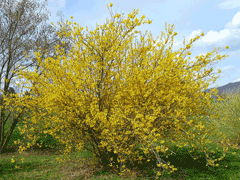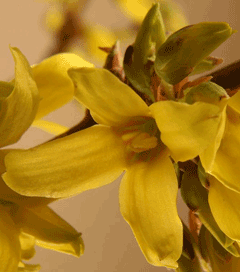 |
|
http://commons.wikimedia.org/wiki/User:4028mdk09 |
 |
| http://commons.wikimedia.org/wiki/User:Hedwig_Storch |
Translate this page:
Summary
Bloom Color: Yellow. Main Bloom Time: Early spring, Late spring, Mid spring. Form: Vase, Weeping.
Physical Characteristics

 Forsythia x intermedia is a deciduous Shrub growing to 2.5 m (8ft) by 2.5 m (8ft) at a fast rate.
Forsythia x intermedia is a deciduous Shrub growing to 2.5 m (8ft) by 2.5 m (8ft) at a fast rate.
See above for USDA hardiness. It is hardy to UK zone 5. It is in flower from March to April. The species is hermaphrodite (has both male and female organs) and is pollinated by Insects.
Suitable for: light (sandy), medium (loamy) and heavy (clay) soils and prefers well-drained soil. Suitable pH: mildly acid, neutral and basic (mildly alkaline) soils and can grow in very alkaline soils.
It can grow in full shade (deep woodland) semi-shade (light woodland) or no shade. It prefers moist soil.
UK Hardiness Map
US Hardiness Map
Synonyms
Plant Habitats
Woodland Garden Dappled Shade; Shady Edge; not Deep Shade; Hedge;
Edible Uses
References More on Edible Uses
Medicinal Uses
Plants For A Future can not take any responsibility for any adverse effects from the use of plants. Always seek advice from a professional before using a plant medicinally.
None known
References More on Medicinal Uses
The Bookshop: Edible Plant Books
Our Latest books on Perennial Plants For Food Forests and Permaculture Gardens in paperback or digital formats.

Edible Tropical Plants
Food Forest Plants for Hotter Conditions: 250+ Plants For Tropical Food Forests & Permaculture Gardens.
More

Edible Temperate Plants
Plants for Your Food Forest: 500 Plants for Temperate Food Forests & Permaculture Gardens.
More

More Books
PFAF have eight books available in paperback and digital formats. Browse the shop for more information.
Shop Now
Other Uses
Hedge Hedge
Can be grown as a tall hedge, the var. 'Lynwood' is frequently used[29]. Var. 'Spectabilis' also makes a good hedge[200] as does 'Beatrix Farrand'[188]. Landscape Uses: Border, Erosion control, Espalier, Pest tolerant, Hedge, Massing, Screen, Specimen.
Special Uses
Espalier Food Forest Hedge Hedge
References More on Other Uses
Cultivation details
An easily grown plant, it succeeds in a well drained ordinary garden soil but prefers a rich soil[1]. Succeeds in limy soils[11]. Prefers a sunny position but succeeds in semi shade[200]. Plants are tolerant of deep shade[219]. A very ornamental plant[1], there are several named varieties. Any pruning out of weak shoots, plus any trimming of hedges, is best done after the plant has flowered[188]. Birds may destroy the flower buds in cold areas[200]. This species is notably susceptible to honey fungus[200]. Special Features:Not North American native, Blooms are very showy. In garden design, as well as the above-ground architecture of a plant, root structure considerations help in choosing plants that work together for their optimal soil requirements including nutrients and water. The root pattern is fleshy. Thick or swollen - fibrous or tap root [2-1].
References Carbon Farming Information and Carbon Sequestration Information
Temperature Converter
Type a value in the Celsius field to convert the value to Fahrenheit:
Fahrenheit:
The PFAF Bookshop
Plants For A Future have a number of books available in paperback and digital form. Book titles include Edible Plants, Edible Perennials, Edible Trees,Edible Shrubs, Woodland Gardening, and Temperate Food Forest Plants. Our new book is Food Forest Plants For Hotter Conditions (Tropical and Sub-Tropical).
Shop Now
Plant Propagation
Seed - sow spring in a cold frame. The seed usually germinates within 2 months[K]. When they are large enough to handle, prick the seedlings out into individual pots and grow them on in the greenhouse for at least their first winter. Plant them out into their permanent positions in late spring or early summer, after the last expected frosts. This is a hybrid species and seed will not come true to type. Cuttings of half-ripe wood 10 - 15cm taken at a node, July/August in a frame. Plant out in autumn or spring. A very high percentage, they root within 3 weeks[78]. Cuttings of mature wood in a sheltered outdoor bed. Good percentage[78].
Other Names
If available other names are mentioned here
Native Range
Coming Soon
Weed Potential
Right plant wrong place. We are currently updating this section.
Please note that a plant may be invasive in one area but may not in your area so it's worth checking.
Conservation Status
IUCN Red List of Threatened Plants Status :

Growth: S = slow M = medium F = fast. Soil: L = light (sandy) M = medium H = heavy (clay). pH: A = acid N = neutral B = basic (alkaline). Shade: F = full shade S = semi-shade N = no shade. Moisture: D = dry M = Moist We = wet Wa = water.
Now available:
Food Forest Plants for Mediterranean Conditions
350+ Perennial Plants For Mediterranean and Drier Food Forests and Permaculture Gardens.
[Paperback and eBook]
This is the third in Plants For A Future's series of plant guides for food forests tailored to
specific climate zones. Following volumes on temperate and tropical ecosystems, this book focuses
on species suited to Mediterranean conditions—regions with hot, dry summers and cool, wet winters,
often facing the added challenge of climate change.
Read More
Expert comment
Author
Zabel.
Botanical References
11200
Links / References
For a list of references used on this page please go here
Readers comment
© 2010, Plants For A Future. Plants For A Future is a charitable company limited by guarantee, registered in England and Wales. Charity No. 1057719, Company No. 3204567.